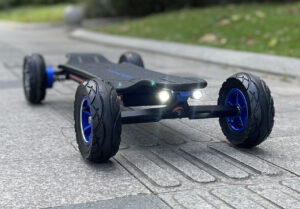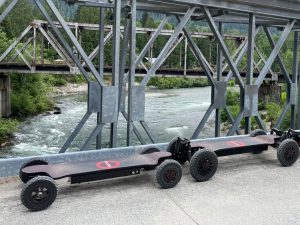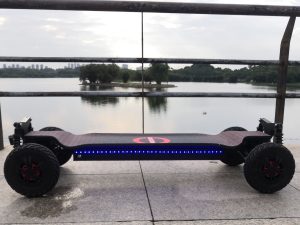The mountain board, sometimes called a mountain scooter, is a two-wheeled board similar to a skateboard but designed for off-road use on dirt trails and rough terrain. It uses larger wheels than a normal skateboard, which allows it to be ridden over bumpier surfaces than asphalt. However, the larger wheels can make stopping more challenging, especially at high speeds or downhill. That’s why mountain board riders must understand the different braking techniques available and when to apply each one. The main stopping techniques are body braking, heel braking, toe braking, and plow stopping.

Body braking
Body braking is one of the most common techniques for slowing and stopping a mountain board.
To perform body braking, the rider needs to lean back away from the direction of travel while bending their knees slightly. This shifts the rider’s weight towards the back of the board and hind wheels. Leaning back engages the momentum of the rider’s upper body, which works against the forward motion of the board, creating friction to slow it down.
For additional control and braking power, the rider can also reach down and grab the board’s front edge or “wedge” with one or both hands. This allows the rider to lock the front of the board upwards and drag it along the ground, maximizing surface contact for braking.
Body braking is effective for gradual and controlled speed reduction on flat or gently sloping terrain. The bending motion absorbs bumps and vibrations for a smoother stop. It remains one of the safest and most versatile braking options in mountain board riding.
Heel braking
Heel braking utilizes the back foot for slowing and stopping the mountain board.
To perform heel braking, the rider pushes downward forcefully with the heel of their back foot against the rear wheel and truck assembly. This hinders the rotation of the back wheel and transfers the braking effort through the entire rolling assembly.
Heel braking is best used for slowing momentum, such as when coming down a hill, and is not as effective for acute stops as other techniques. By maintaining consistent heel pressure, the rider can steadily bleed off speed without risking loss of control. It allows e-board riders to brake with only one foot, freeing up the other foot to keep proper form and balance as terrain changes beneath them. Heel braking pairs well with body braking for gradual and sustained slowing on various surfaces and slopes.

Toe braking
Toe braking is an important technique that allows mountain board riders to precisely control their speed. It involves using the toes of the back foot to gently grip the top edge of the rear wheel. By varying the toe pressure applied, riders can speed up or gradually slow down as needed.
Toe braking manipulates just one wheel, so it’s a sensitive method that demands good balance skills. It works best at lower to moderate speeds on flat or gently sloping surfaces when more delicate steering and velocity management are required. Some examples include navigating technical sections, keeping pace in group rides, or slowing approach before maneuvers. Toe braking pairs well with body braking, as riders can dynamically engage their upper body, back foot toes, or both in tandem based on changing momentum.
With practice, the braking becomes an intuitive way to delicately fade speed.
Plough stopping
Plough stopping is one of mountain boards’ fastest and most dramatic braking techniques. It involves lifting the front half of the board off the ground while dragging the back half and wheels.
To perform a plow stop, riders shift their weight back and then sweep the front of the board upwards in an arc using both hands. This causes the rear trucks and wheels to plow or drag against the terrain, digging in and abruptly halting forward momentum. Plough stopping works best when going fast downhill or in emergencies, as it brings about an immediate and forceful halt. However, it requires space to bleed off speed and carries a greater risk of losing control or falling if performed improperly. Riders must have the strong upper body strength to control the board during a plow stop, especially in rough conditions.
It’s not a method suited for gradual braking but is a valuable dramatic slow-down option in the mountain board rider’s toolbox.

Conclusion
In conclusion, while all braking techniques have advantages, honing the fundamentals and understanding when to apply each method allows mountain board riders to confidently and safely navigate different terrains. To review, body braking provides balanced control for typical slowdowns, while heel and toe braking allows more finessed speed regulation. Plough stopping serves as an emergency measure for fast descents.
With regular practice, a rider can dynamically blend body, heel, and toe braking variations for gradual and sustained stopping power across various conditions and terrain. However, plow stops require open spaces due to their abrupt nature. The key is recognizing when more dramatic braking may be needed versus simpler techniques.
With experience, mountain boarders can learn to seamlessly transition between the different braking styles based on evolving riding scenarios, always prioritizing safety. Mastering multiple methods and proper form, balance, and body positioning ultimately gives riders reliable stopping power in any situation.
Read More
- The Best Electric Skateboard With An Affordable Price – Ecomobl
- Electric Skateboard Range – Ecomobl
- Off Road Electric Skateboarding Tips – Ecomobl
- Electric Skateboards Power Usage – Ecomobl
- How Can I Make My Electric Skateboard Faster – Ecomobl




